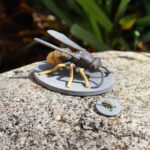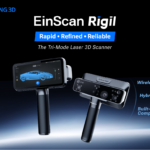Sandia National Laboratories, in collaboration with Wetzel Wind Energy Services and Stratasys Direct Inc., has designed an innovative turbine blade tip that could significantly improve the efficiency of wind energy production. This new design is part of the Additively Manufactured System Integrated Tip (AMSIT) project, which aims to integrate advanced technologies into wind turbine components, ultimately reducing the cost of electricity generated by wind turbines.

A New Approach to Turbine Blade Design
The AMSIT project, funded by the U.S. Department of Energy’s Advanced Materials and Manufacturing Technologies Office, addresses several challenges currently faced in turbine blade manufacturing. These include issues with manual composite-fiber-epoxy processes, quality control problems leading to blade defects, erosion damage, and the high costs and complexities associated with transporting large blades.
The key innovation in this project is the use of 3D printing to create a modular blade tip. Brent Houchens, the principal investigator of the AMSIT project, explained, “3D printing offers a path to address all of these issues by integrating technologies. We considered a winglet to increase lift, surface texturing to reduce flow separation, and features to improve leading-edge erosion protection and lightning protection.”
This 3D-printed blade tip, designed for a 200 kilowatt-scale turbine with 13-meter blades, replaces about 15% of the traditional blade tip. The new design improves aerodynamic performance with an upwind winglet and surface texturing while also incorporating integrated protection against erosion and lightning. The modular nature of the design allows for easier and faster replacement of damaged tips, such as those struck by lightning, potentially reducing downtime and maintenance costs.

Impact on Wind Energy Costs
One of the main goals of the AMSIT project is to reduce the levelized cost of electricity (LCOE) over the lifetime of a wind turbine. Initial models indicate that the new blade tip design could decrease the LCOE by 3%-4% on average at wind speeds below 10 meters per second. This reduction is achieved without altering the maximum rated power of the turbines, allowing the AMSIT blades to be tested on existing machines.
The integration of 3D printing in turbine blade manufacturing also opens up new possibilities for exploring complex geometries that are challenging to produce using traditional methods. As 3D printing technology advances and becomes more cost-effective, the LCOE for designs like AMSIT is expected to continue decreasing.
Testing and Fieldwork
To ensure the durability of the 3D-printed materials, AMSIT researchers conducted laboratory tests to simulate lightning strikes on the blade tips. These tests included scenarios with direct strikes to a simulated lightning protection system, surface strikes away from the system, and strikes without any protection. The results from these tests will inform further development and optimization of the blade tips.
The team also used laser scanning to accurately match the 3D-printed tips to the existing blades. The outer shell of the blades was removed to attach the new tips and winglets, which were then subjected to ground-based structural tests. These components will be further tested at the Sandia Scaled Wind Farm Technology site in Lubbock, Texas, where they will undergo field demonstrations.
According to Brent Houchens, the AMSIT project exemplifies how 3D printing can enhance the performance and reduce the costs of wind energy. “The AMSIT project demonstrates how integrating technologies through 3D printing could reduce the cost of wind energy by improving aerodynamic performance and reducing repair costs,” he said. Following the completion of the project, the modified blade root and stub will be available for testing other novel tip designs, paving the way for future innovations in wind turbine technology.
Source: sandia.gov










